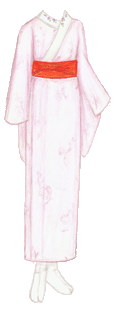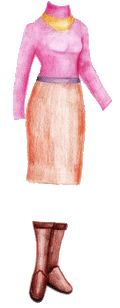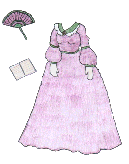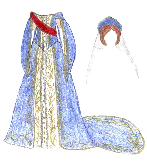 Click for larger version (PNG); click for PDF version. Click here for the list of dolls.
Click for larger version (PNG); click for PDF version. Click here for the list of dolls.
I was once asked why I never drew Japanese clothes, and the answer was simple: not only do I not know enough about them, but I know I don’t know enough about them. If I was a Civil War historian or a Marie Antoinette fangirl, it would probably bug me to draw inaccurate clothing from those time periods, but I’m not, so I do my best based on historical sources, and if the general shape and decoration are plausible, it’s fine with me if the colors aren’t quite right. However, I studied Japanese literature and culture in college, and I still study the Japanese language off and on even now, so if I drew Japanese clothes with imperfect understanding, it would really bother me. I had picked up a book on kimono in college, but had only skimmed everything about the history of kimono and modern-day kimono because the part I was interested in was clothing from around 800-1000 A.D., as I was studying Heian-era literature. But I did manage to pick up that modern kimono were bound by rules and the patterns, colors and way of wearing them were all laden with significance.
At the same time, I wasn’t all that interested in Japanese clothes: as you might have guessed, I like crazy full skirts, ruffles, interesting things to shade and varying silhouettes: kind of the opposite of the kimono in every way. Kimono just seemed boxy, prim and plain to me. Plus, I didn’t understand the underlying color sense: for example, what makes a particular obi go with a particular kimono? I’m well aware that what seems aesthetically pleasing to me is in large part influenced by my cultural background, and if I looked at a kimono I just felt like I didn’t even know how to start understanding it, much less draw one on my own.
This was around spring of 2010, and since then, I’ve been educating myself about kimono. My primary English source was the excellent Kimono: Fashioning Culture, which answered most of my questions, but I’ve also been reading other books such as The Book of Kimono and Japanese Costume and Textile Arts, I picked up a Japanese book, 家じゅうの着つけと帯結び (Wearing Kimono and Tying Obi for the Whole Family) which makes a lot of this information much less abstract, and I’ve spent a lot of time looking at online stores, magazines and reading things such as The Kimono Lady, Japan Now and Then and the Immortal Geisha forums, where English-speaking kimono enthusiasts post pictures of themselves in kimonos, the latest accessories they’ve bought or made and questions about everything related to kimono. I love and appreciate kimono, now, and although I expect to make a great many mistakes I’m ready to start drawing them. I want to explore kimono colors, patterns, history and so on through my paperdolls, and I hope you all enjoy it too.
Before we get into all that, we’ll start with the most basic of basics. The kimono (着物、きもの) is an ankle-length robe with a lapped front and long sleeves, worn with a wide, stiff sash called an obi (帯、おび). Historically, for America and Europe, “fashion” has meant the way the shapes of garments changed: think of the differences between 1860s hoop skirts, 1890s bustles and 1920s flapper dresses. In Japan, the basic shape of the kimono has changed very little since it was adapted from China, especially since Western clothes became popular for daily wear, and it is color and pattern that really show a garment’s age, worth and purpose. Originally, the kimono was called a kosode (小袖、こそで, meaning small sleeve), and it was white and worn under pants and other robes; as time went on, it was freed from these other layers and became elaborately decorated. In the same way, the obi was once just a regular fabric sash, but it widened to balance out the kimono and often became more expensive than the kimono itself. Modern-day kimono are mainly worn by women as a formal garment, and the way the kimono is cut, worn, colored and patterned indicates things like the wearer’s age, the season and the occasion.
I’ve gone with the most basic of basics for today’s drawing, too: kimono underwear! First, you put on the white split-toed socks called tabi (足袋、たび), because after you’re wearing the full kimono, it’s hard to bend over enough to put them on. Next, you wear a kimono bra (和装ブラジャー, わそうブラジャー), which looks like a sports bra and flattens the chest, and over that a short-sleeved overshirt called a hada-juban (肌襦袢、はだじゅばん) and a wrap skirt that ends about below the calves called a susoyoke (すそよけ), which mainly serve to trap sweat. It looks like you can also get a single garment that combines those last two, as well, although my book doesn’t have a picture of it. The ideal body shape for wearing kimono for a formal occasion is basically cylindrical, so at this point, you might use a towel or other fabric to pad out areas such as your waist or shoulders.
Over all this goes the naga-juban (長襦袢、ながじゅばん), which is just a little shorter than the actual kimono but otherwise has the same shape. The neckband of the naga-juban is covered by a collar called a han-eri (半襟、はんえり), which is sewn on to prevent the neckband of the naga-juban from getting dirty and can be easily replaced. The han-eri and the inside of the wrists of the naga-juban are the only parts of the underwear that show when the kimono is worn. Generally, and particularly for formal kimono, the han-eri is pure white, but there are also colored and embroidered han-eri. The naga-juban is secured around the waist with a thin sash called a koshi-himo (腰紐、こしひも), then a date-jime (伊達締め、だてじめ), a wider sash, is tied around the waist again. This is because when you put on the naga-juban, you determine where the back of the neckband will be. It isn’t worn right on the neck like you would wear a robe: it’s supposed to show the nape of the neck a bit, but not too much. The purpose of the date-jime is to keep the neckband in place.
At this point, you’re ready to put on the kimono itself! At some point, we’ll look at what the shape of the kimono can tell you.
This is a naga-juban and date-jime based on the pictures from Wearing Kimono and Obi Tying for the Whole Family, which was also the source of my information about kimono underwear. (I couldn’t resist adding some embroidery around the collar, though.) Most of the historical information is from Kimono: Fashioning Culture.
 Click for larger version (PNG); click for PDF version. Click here for the list of dolls.
Click for larger version (PNG); click for PDF version. Click here for the list of dolls. Share
Share







